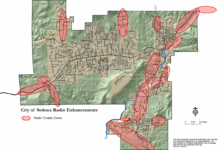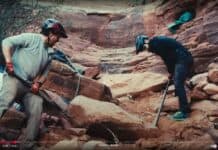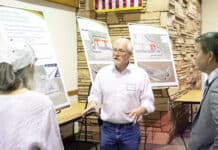The city of Sedona spent $1.8 million on experts and studies during the years from 1999 to the early part of 2008, on average $200,000 per year.
More than a million of those dollars was consumed by the Public Works Department for studies and plans on sewers, drains and traffic design.
Another quarter-of-a- million dollars bought expertise in subjects for the Community Development Depart-ment, including transit feasibility, housing studies and historical resources.
By Susan Johnson
Larson Newspapers
The city of Sedona spent $1.8 million on experts and studies during the years from 1999 to the early part of 2008, on average $200,000 per year.
More than a million of those dollars was consumed by the Public Works Department for studies and plans on sewers, drains and traffic design.
Another quarter-of-a- million dollars bought expertise in subjects for the Community Development Depart-ment, including transit feasibility, housing studies and historical resources.
Development impact fee studies cost $80,000 and a combination of the feasibility of a performing arts and conference center and an analysis for a recreation center chewed up $130,000.
Some residents and candidates are critical of the amount of money spent and also the choice of experts.
City Manager Eric Levitt said that he is not a big fan of hiring consultants to perform studies, but that in some cases they prove valuable, saving the city hundreds of thousands of dollars.
“The city has a small staff and our engineers and other professionals have to be generalists in order to cover the broad scope of their responsibilities,” Levitt said. “Sometimes, we need specific expertise that we don’t have on staff or can’t afford to have on our staff.”
The stormwater master plan, in addition to the work performed by city staff on reviews and preparing background information, would have required hiring nearly a dozen people, according to City Engineer Charles Mosley.
“The consultant estimated 2,500 man hours and it probably took more,” Mosley said. “We would have had to hire an expert hydrologist, hydraulic engineer, draftsmen, surveyors, cost analysis engineer, project manager and several assistants to perform the same work,” Mosley said.
Hiring the consultants allowed the city to incur a one-time expense rather than ongoing salaries and benefits and also avoided the expense of dedicated computer software and adding workspace to the complex, Mosley said.
Director of Community Development John O’Brien had a similar view of the housing policy study.
“Contracting this work out allowed us to hire an expert in the housing field who had 17 years experience with the Arizona Department of Commerce and the Arizona Department of Housing,” O’Brien said. “We didn’t have this expertise in-house and it would have been difficult to hire an employee to perform this function.”
Many of the projects that were studied were subsequently implemented in whole or in part, including the stormwater master plan, although a few others were not.
A space assessment study that cost $35,000 was never used to rearrange the city complex, but Levitt said that it is regularly used to calculate the true cost of requests received from staff for additional space or new offices.
“Implementing the study would have cost us between $5 million and $7 million,” Levitt said. “Instead, we use it as a mark of what’s reasonable to do and that’s saved us hundreds of thousands of dollars.”
It’s been suggested by some that using expert volunteers could save the city money, however, Levitt has reservations about this strategy.
“Volunteers typically don’t have the liability coverage that a professional firm would have,” Levitt said.
Incumbent Mayor Pud Colquitt agreed.
“We already get much expert volunteer help through our commissions and committees,” Colquitt said. “The biggest risk of using volunteers for studies is liability and meeting the many special requirements the city must adhere to when contracting out work.”
Mayoral candidate Matthew Turner had two issues:.
“The biggest risk is lack of liability insurance in case a problem develops with the services they perform,” Turner said. “In addition, they may be less motivated to complete the job because they’re not being paid.”
Mayoral candidate Councilman Rob Adams is a supporter of using citizen advisory committees for research and advice, but saw risks as well.
“The risk in using volunteers is ensuring that they have the time to do the work and are unbiased in their advice,” Adams said.
Council candidate Marc Sterling had additional concerns.
“An expert volunteer might not actually have all the current knowledge necessary to make the most informed recommendation or decision,” Sterling said.
Council candidate Cliff Hamilton saw only positives in using volunteers.
“Sedona is notorious for doing expensive studies, shelving them and hiring consultants who take the city for large sums and give us back wrong information,” Hamilton said. “A lot more people in Sedona would get involved in what’s happening in their community [if we used volunteers], creating ownership in city affairs.”
Incumbent Councilman John Bradshaw thinks volunteers can work in certain circumstances.
“I don’t see a whole lot of risk using volunteers, but you need safeguards, including having them work with appropriate staff so that you get more than one opinion,” Bradshaw said.
Due to time constraints, council candidates Suzy Chaffee and Dan Surber did not have the opportunity to comment.
Susan Johnson can be reached at 282-7795, Ext. 129 or e-mail sjohnson@larsonnewspapers.com





















